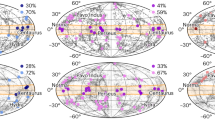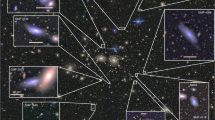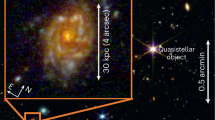Abstract
The distinction between elliptical and disk galaxies is often explained by invoking different rates of dissipation and star formation in the proto-galactic gas clouds from which they are presumed to have formed1–3. Another possibility is raised by the suggestion that many ellipticals are the remnants of galaxies that merged while suffering the tidal distortion and violent relaxation of a slow encounter4,5. Various N-body simulations indicate that merging can account for many of the observed properties of bright elliptical galaxies6–9, although some reservations have been expressed about the possibility of accounting for their low rotation velocities10. My aim here is to consider a specific model for the formation of disk galaxies by dissipation and the formation of bright ellipticals by merging and to suggest that it can account for their rotation properties in a natural way.
This is a preview of subscription content, access via your institution
Access options
Subscribe to this journal
Receive 51 print issues and online access
$199.00 per year
only $3.90 per issue
Buy this article
- Purchase on SpringerLink
- Instant access to full article PDF
Prices may be subject to local taxes which are calculated during checkout
Similar content being viewed by others
References
Sandage, A., Freeman, K. C. & Stokes, N. R. Astrophys. J. 160, 831 (1970).
Gott, J. R. & Thuan, T. X. Astrophys. J. 204, 649 (1976).
Binney, J. Mon. Not. R. astr. Soc. 177, 19 (1976).
Toomre, A. & Toomre, J. Astrophys. J. 178, 623 (1972).
Toomre, A. in The Evolution of Galaxies and Stellar Populations (eds Tinsley, B. M. & Larson, R. B.) 401 (Yale University Observatory, New Haven, 1977).
White, S. D. M. Mon. Not. R. astr. Soc. 184, 185 (1978); Mon. Not. R. astr. Soc. (in the press).
Roos, N. & Norman, C. A. Astr. Astrophys. 76, 75 (1979).
Jones, B. J. T. & Efstathiou, G. Mon. Not. R. astr. Soc. (in the press).
Aarseth, S. J. & Fall, S. M. Astrophys. J. (in the press).
White, S. D. M. Astrophys. J. Lett. 229, L9 (1979).
Peebles, P. J. E. Astrophys. J. 155, 393 (1969).
Efstathiou, G. & Jones, B. J. T. Mon. Not. R. astr. Soc. 186, 133 (1979).
Bertola, F. & Capaccioli, M. Astrophys. J. 200, 439 (1975).
Illingworth, G. Astrophys. J. Lett. 218, L43 (1977).
Young, P., Sargent, W. L. W., Boksenberg, A., Lynds, C. R. & Hartwick, F. D. A. Astrophys. J. 222, 450 (1978).
Davies, R. thesis, Cambridge Univ. (1978).
Schechter, P. L. & Gunn, J. E. Astrophys. J. 229, 472 (1979).
Freeman, K. C. Astrophys. J. 160, 811 (1970).
Watson, G. N. A Treatise on the Theory of Bessel Functions (Cambridge University Press, 1922).
White, S. D. M. & Rees, M. J. Mon. Not. R. astr. Soc. 183, 341 (1978).
Larson, R. B. Mon. Not. R. astr. Soc. 176, 31 (1976).
Eggen, O. J., Lynden-Bell, D. & Sandage, A. Astrophys. J. 136, 748 (1962).
Ostriker, J. P., Peebles, P. J. E. & Yahil, A. Astrophys. J. Lett. 193, L1 (1974).
Krumm, N. & Salpeter, E. E. Astr. Astrophys. 56, 465 (1977).
Mestel, L. Mon. Not. R. astr. Soc. 126, 553 (1963).
Peebles, P. J. E. Astrophys. J. Lett. 189, L51 (1974).
Gott, J. R. & Rees, M. J. Astr. Astrophys. 45, 365 (1975).
Author information
Authors and Affiliations
Rights and permissions
About this article
Cite this article
Fall, S. Dissipation, merging and the rotation of galaxies. Nature 281, 200–202 (1979). https://doi.org/10.1038/281200a0
Received:
Accepted:
Published:
Issue date:
DOI: https://doi.org/10.1038/281200a0
This article is cited by
-
Lost and found dark matter in elliptical galaxies
Nature (2005)
-
From dwarfs to giants — signposts of galaxy formation
Nature (1983)
-
Homogeneous sample of double galaxies. III. kinematics and structure
Astrophysics (1982)



